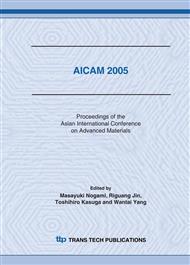p.47
p.53
p.57
p.61
p.65
p.69
p.73
p.77
p.81
Relationship between the Thermal Expansion Coefficient and the Composition for R2O-MO-Al2O3-SiO2 System Glass
Abstract:
The R2O-MO- Al2O3-SiO2 system glasses were prepared by conventional melt quenching technology. The composition mass fraction range of the glass is SiO2 (55%∼65%), MgO (0%∼15.2%), CaO (0%∼15.2%), SrO (0%∼15.2%), BaO (0%∼15.2%), Na2O (0%∼15.6%), K2O (0%∼15.6%). The relationship between the composition and the thermal expansion coefficient of the glass was investigated by comparing the thermal expansion coefficients of the glasses with different chemical composition. The results show that the thermal expansion coefficient of the glass increases sharply with the increase of alkali-metal oxide content and when K+, Na+ and Li+ exist simultaneously in the structure of the glass, the complex “mixed alkali effect” can be observed from the composition–thermal expansion coefficient curve. When introducing different kind but same quantity alkaline-earth metal oxide, the thermal expansion coefficient of the glasses increased obviously with the rising of the radius of alkaline-earth metal ions but the “mixed alkali effects” can also be observed for the glasses containing a few kinds of alkaline-earth metal oxides.
Info:
Periodical:
Pages:
65-68
Citation:
Online since:
February 2006
Authors:
Price:
Сopyright:
© 2006 Trans Tech Publications Ltd. All Rights Reserved
Share:
Citation:


